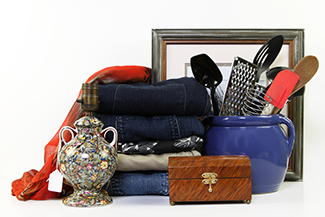The Golden Rule of Organizing | One Thing In, One Thing Out
The Golden Rule of Organizing | One Thing In, One Thing Out
If you can’t find a place to store a new purse, shirt, golf accessories, kitchen gadgets, or whatever item you have too many of, it’s time to declutter and organize. When you can’t find two shoes that match, it’s time to declutter and organize.
“This is when the One In, One Out rule is necessary,” said Bridges Conner, a professional organizer. She is the owner and founder of Get Organized with Bridges + CO , Past President of the National Association of Productivity and Organizing Professionals Arizona Chapter NAPO-AZ, and a Rosie-Certified Partner.
The One In, One Out Rule
 The One In, One Out rule is one of the Golden Rules professional organizers live by. Every time a new item comes into your home, a similar item must leave. For example, if you buy a new pair of jeans, get rid of a pair you no longer wear.
The One In, One Out rule is one of the Golden Rules professional organizers live by. Every time a new item comes into your home, a similar item must leave. For example, if you buy a new pair of jeans, get rid of a pair you no longer wear.
“Typically, we only wear 20 percent of our stuff 80 percent of the time,” said Conner. “If your closet is overflowing with clothes, an easy way to see what you wear within six months to a year is to turn your hangers backward. When you wear an item and are ready to put it back, turn the hanger the right way. At the end of six months or a year, the hangers that are still backward are the items you aren’t using and should be purged or donated.”
Respect Your Boundaries
It is easy for the things we don’t need, use, or love to wind up getting crammed into spaces that are too small. It is important to set organizing boundaries and then respect them. Conner suggests living within the boundaries that you have set for a given space, to ensure that space is going to function as intended. For example, too many shoes will eventually flow out of the closet into the hallway, under the bed, and basically, any place that is not where they should be. Now there is clutter and multiple spaces that are no longer functional. Work within the boundaries of your space and don’t accumulate excess items that prevent your space from being functional.
Keep, Donate, Sell
 Keep
Keep
Keep items you know will be used. Just be sure to organize them so they can easily be found.
Donate
Once you have decided to scale down, the next step is deciding what to keep, donate, or sell. Conner keeps a Goodwill bag in her closet and garage. It serves as a reminder that when she brings something new into her home, she must exchange out something else. When the bags are full, she drops them off at a donation center.
There are many non-profit organizations in need of clothes, shoes, furniture, kitchenware, and other household items. For example:
St. Vincent de Paul | Statewide Locations
Habitat for Humanity | Statewide Locations
Queen Esther’s Closet | Prescott Valley
Assistance League of Flagstaff | Flagstaff
Humane Society of Southern Arizona | Tucson
White Elephant | Green Valley
HALO Thrift Boutique | Cave Creek
Friends of the Library | Sedona
There are countless non-profits to choose from all over Arizona. Select one that benefits a foundation that suits your interests (animals, veterans, homelessness, education, women, etc.).
Tax Tip: Before delivering your items, Conner suggests taking photos, printing and attaching them to the copy of your donation receipt. This will be helpful at tax time.
Sell
 If your items are in very good condition, why not make a few bucks off them? Take them to a consignment shop.
If your items are in very good condition, why not make a few bucks off them? Take them to a consignment shop.
Great deals on quality items can be found in consignment stores. Shoppers can have the goods they want at a lower price, and consigners see items that might have gone to waste, create revenue. Consigning also frees up space in your house to help you get more organized and eliminate clutter.
This how it works: Consigners set up an account with the shop to keep track of the money earned from the sale of their items. A percentage of the sale price is given to the consignor (you). The shop will give you a check and an itemized list to let you know which item sold and how much you received from the sale.
Many shops have a timeline where an item will go down in price once it has been on the floor for a certain number of days. For example, if a blouse has been for sale for 30 days, it is 25 percent off, for 60 days, it is 50 percent off, and for 90 days, it is 75 percent off. This presents an even greater opportunity for savings and increases sales for the consigner.
Consignment stores can be very particular about the items they will accept. Some clothing-only shops will take clothes that are clean, without stains or tears, not visibly worn out, doesn’t have any odor or wrinkles, is in season, and is in line with the current fashions.
“Many items do not pass the test put forth by the consignment shop, but this is to ensure the buyer the best quality the shop can provide. When the shops have more product than they can use or accommodate, they either return them to the consigner or donate them to a local charity. Nothing is wasted, said Conner.
Implementing the One In, One Out rule will make organizing less overwhelming, and in time new, helpful habits will be formed.
Podcast
Home Maintenance To-Do | #OutWithTheOldInWithTheNew
###
Photo Credits:
- Rosie on the House
Resources:
- ROSIE ESTORE: Get Organized with the Store It! Cabinet Caddy
- Blog: Ready, Set, Go! January Is National Get Organized “GO” Month
- DIY FAQ: Finding New Homes for Clutter!
- DIY FAQ: Making Space For New Stuff In Your Home
- DIY FAQ: Tackling The Challenge of Recycling
- DIY FAQ: 12 Clever Cabinet Ideas that You Need for Your Kitchen
- DIY FAQ: How Do I Go About Decluttering My Home?
